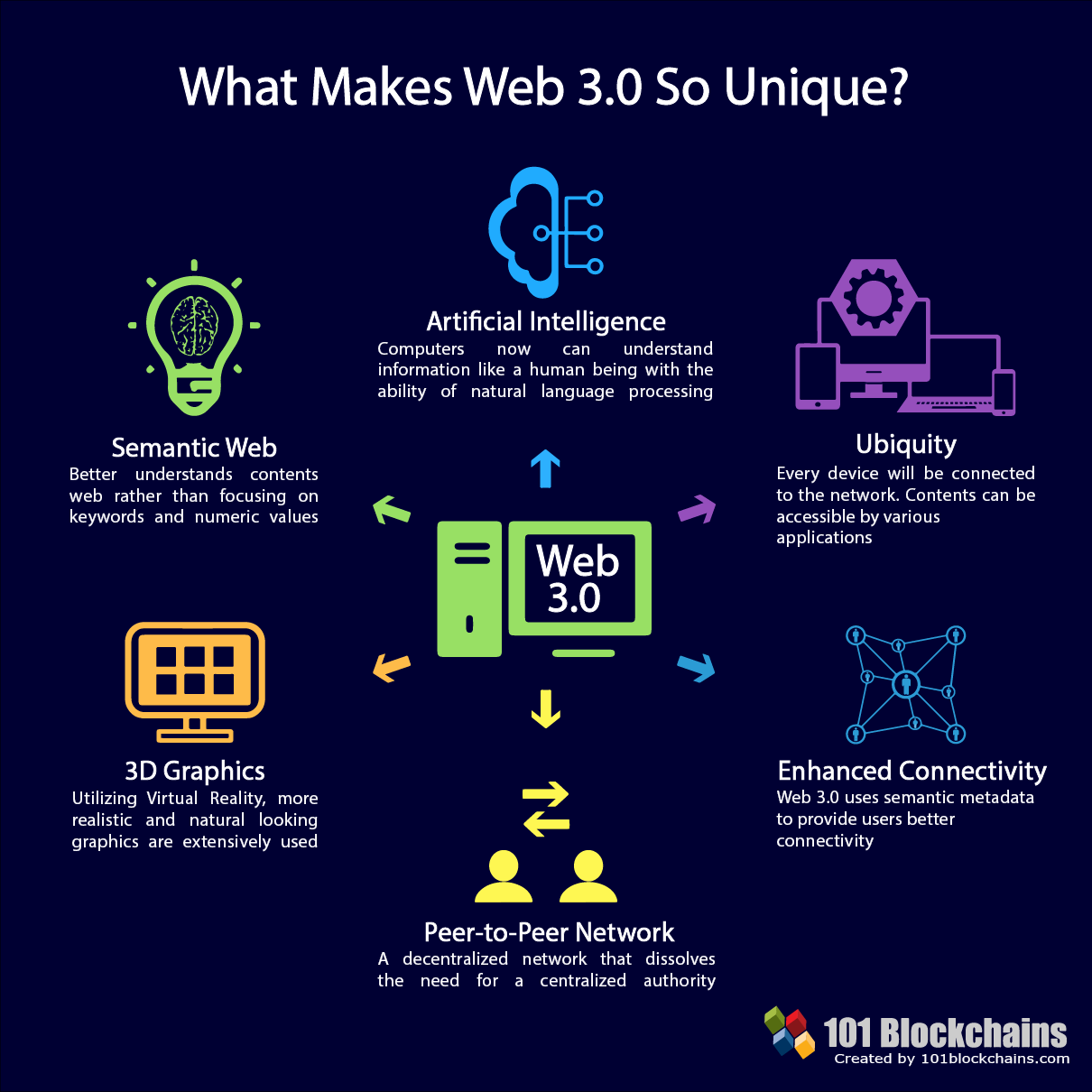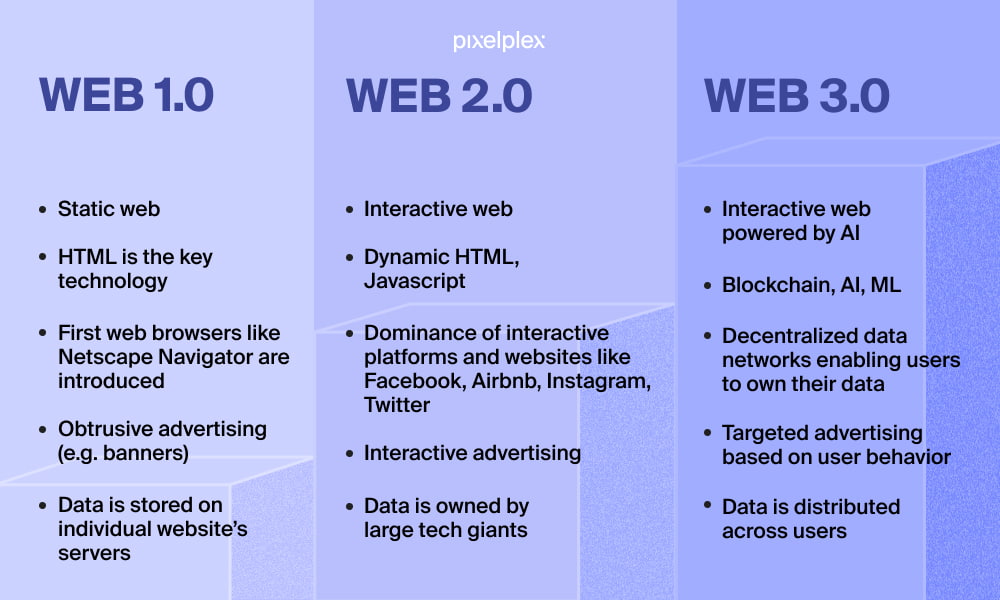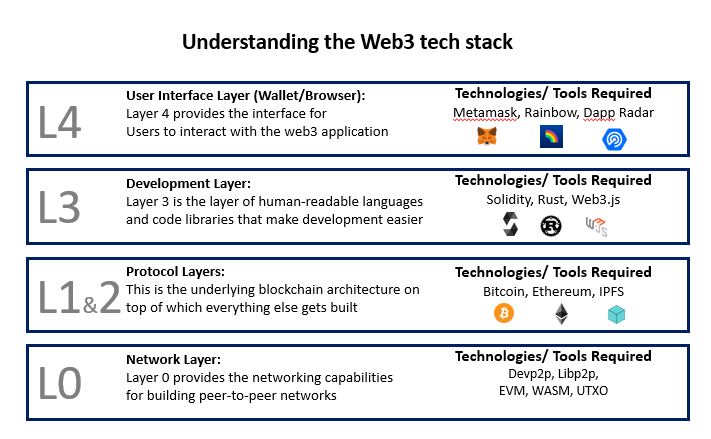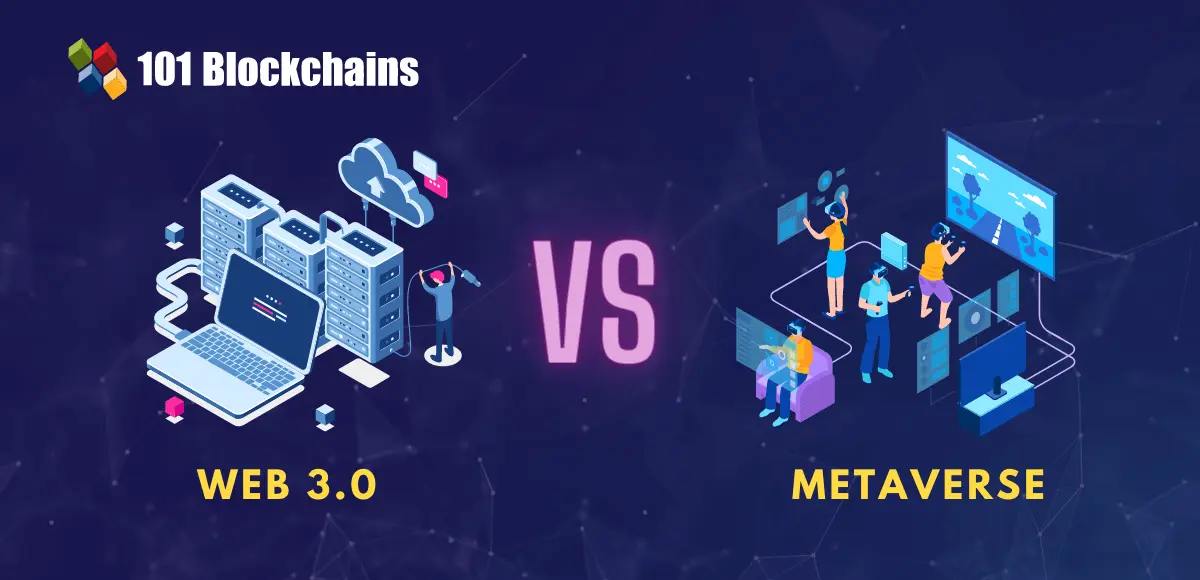This article was published as a part of the Data Science Blogathon.
Introduction
Web 3.0 revolution is the next generation of the World Wide Web, where the focus is on data-driven applications and content. It is based on the Web 3.0 stack, which includes a semantic web, a social web, and a mobile web. Web 3.0 is the third stage of development of the World Wide Web, following Web 1.0 and Web 2.0. It has been described as a “read-write” or a Semantic Web. Web 3.0 is still in its early stages of development, but it is hoped that it will allow the World Wide Web to become more interactive and user-friendly. One of Web 3.0 goals is to make the web more intelligent to understand users’ needs better and provide them with the information they want.
A Glance at the Current State of Internet Usage Worldwide
Internet usage has grown exponentially in the past two decades, causing a web 3.0 revolution worldwide. Today, over 5 billion people worldwide use the internet regularly, with over 2.5 billion using it daily. The internet has become an essential part of daily life for many people, with many activities being carried out online. These include:
1. Communication: Email, instant messaging, social networking, and video conferencing are popular ways of staying in touch with friends and family.
2. Information gathering: The internet is used as a research tool for school, work, and personal projects.
3. Entertainment: Music, TV, movies, and games can all be accessed online.
4. Shopping: More and more people are buying goods and services online, from clothes and books to holidays and flights.
5. Banking: Online banking is commonplace, allowing people to check their balances, make payments, and transfer money.
Technologies that Use Web 3.0
Web 3.0 is the third generation of the World Wide Web. It is characterized by advances in web technology that allows for more interactive and user-friendly web experiences leading to the Web 3.0 revolution. Some technologies associated with Web 3.0 include Natural Language Processing, Semantic Web, Artificial Intelligence, etc.
1. Natural Language Processing:
Natural language processing (NLP) studies how computers interact with human (natural) languages in computer science, artificial intelligence, and linguistics. NLP is associated with the field of human-computer interaction as a result. Natural language comprehension enables computers to interpret human or natural language input, and natural language production is among the many issues in NLP.
NLP research has been applied to several tasks, including text classification, topic detection, sentiment analysis, document summarization, machine translation, and question-answering.
In the early days of NLP, much of the research was focused on the task of machine translation. However, NLP has broadened its scope and is now applied to many jobs involving understanding or generating natural language text.
One of the most critical tasks in NLP is text classification. Text classification is assigning a class label to a piece of text.
2. Semantic Web:
The Semantic Web is an extension of the World Wide Web that enables machines to read and interpret web content. Semantic Web technologies allow web developers to create web pages that can be read and understood by engines. It makes it possible for machines to process and understand web content in a way similar to how humans do.
The Semantic Web is built on the idea of making the structure of data on the web more explicit. It uses standards such as the Resource Description Framework (RDF) and the Web Ontology Language (OWL). These standards enable web developers to add metadata to their web pages. It can use this metadata to describe the page’s content, the relationships between different pieces of content, and the meaning of the content.
The Semantic Web is still in its early stages of development. However, it has the potential to revolutionize the way that machines interact with the web.
3. Artificial Intelligence:
There is a new era of the internet known as Web 3.0. This latest version of the internet is powered by artificial intelligence (AI) and is changing how we interact with the web. With Web 3.0, we can expect a more personalized and interactive experience with the help of AI.
We are already starting to see the effects of AI on the internet. For example, Google’s search engine is now using AI to provide more relevant results to users. Google’s RankBrain is an AI system constantly learning and improving the search results it provides.
In the future, we can expect AI to have an even more significant impact on the internet. For example, AI could help us find the information we are looking for more quickly and easily. We could also use AI to create personalized experiences on websites and social media platforms.
4. 3D Graphics:
3D graphics are everywhere these days. They are used in movies, video games, product designs, and the web. While 2D graphics have been around since the early days of the web, 3D graphics are a relatively new addition.
There are a few ways that We can use 3D graphics on the web. One is to create an interactive 3D model that users can view and manipulate. We can use it for things like product demonstrations or architectural visualizations.
Another way to use 3D graphics on the web is to create a 3D scene that We can navigate. We can use it to create an immersive game environment or give users a virtual tour of a space.
Finally, We can also use 3D graphics for purely aesthetic purposes. It can be anything from adding a simple 3D object to a web page to creating a full-fledged 3D animation.
There are a few ways that We can use 3D graphics in web 3.0. One way is to use a plugin like Flash or Java to create a 3D environment that can be interacted with. Another way is to use a 3D engine to create an interactive 3D world that the user can explore. And finally, some web browsers now have native support for 3D graphics, meaning we can directly embed 3D content into a web page without needing any plugins or extra software.
5. Blockchain:
Blockchain is a distributed ledger technology that allows for secure, transparent, and tamper-proof record-keeping. Each transaction is verified and stored using a distributed computer network in a public ledger. It makes it virtually impossible for fraudsters to tamper with the data.
Web 3.0 is the next generation of the internet, where users are in control of their data. With blockchain technology, web 3.0 will be a more secure and transparent internet.
We can use blockchain to create a decentralized internet, where there is no single point of control. It would make it much harder for government and corporations to censor or interfere with internet users.
We can also use blockchain to create a more secure and private internet. By using blockchain, web 3.0 will be more resistant to hacks and data breaches.
In conclusion, a blockchain is a powerful tool that it can use to create a more secure, transparent, and decentralized internet.
6. Internet of Things:
The network of objects sometimes referred to as the internet of things, is the interconnection of physical objects such as machinery, cars, and buildings that are outfitted with electronics, software, sensors, actuators, and network connections to gather and exchange data.
The development of web 3.0 technologies such as social networking, blogs, wikis, and folksonomies has created a new generation of internet users who are more collaborative, networked, and empowered than ever. This so-called Web 1.0 generation is now starting to apply these same principles to the physical world with the emerging field of the internet of things.
The internet of things is all about connecting physical objects to the internet so that they can communicate and be controlled remotely. It is achieved by embedding objects with sensors and actuators to collect and exchange data and provide them with a network connection.

Difference Between Web 1.0, Web 2.0, and Web 3.0
In this section, we will see the difference between Web 1.0, Web 2.0, and Web 3.0
What is Web 1.0?
The first generation of the World Wide Web was a simple yet revolutionary way to share information and connect people from all over the globe. Web 1.0 was all about static content and simple HTML pages that were easy to navigate and explore. Although there wasn’t much in terms of interactivity or dynamic content, the first generation of the web was a crucial step in the evolution of the internet as we know it today.
What is Web 2.0?
Web 2.0 is the second generation of the World Wide Web, characterized by increased user interactivity and collaboration, more sophisticated web applications, and a shift from static HTML pages to a more dynamic web.
Whereas the first generation of the web was about connecting people and information, Web 2.0 is about connecting people and ideas. It’s about collaboration and user-generated content. And it’s about web applications that make it easy for people to work together and share information.
Some popular Web 2.0 applications include social networking sites like Facebook and Twitter, wikis like Wikipedia, and video-sharing sites like YouTube. But there are many, many more.
Web 2.0 has had a profound impact on the way we use the web. It’s made it possible for people to connect and collaborate in ways that were once unimaginable. And it’s given rise to a new generation of web-based businesses and applications.
How is Web 3.0 Different from Web 2.0?
Web 3rd gen differs from web 2nd gen in a few key ways:
- The web 3rd gen is built on top of the Semantic Web, which enables machines to understand and interpret web content more. It, in turn, allows for more intelligent search and data mining.
- Web 3rd gen sites are more likely to use open standards and protocols, which makes them more accessible and interoperable.
- Web 3rd gen sites are more likely to be decentralized, using peer-to-peer technologies to share data and improve performance.

Disadvantages of Web 3.0
There are several disadvantages associated with web 3.0 technologies:
1. They are relatively new, and therefore there is a lack of understanding and skills surrounding their use. It can make it difficult for businesses to take full advantage of these tools and limit their potential.
2. Web 3.0 technologies can be complex and expensive to implement. It can make it difficult for small businesses to adopt these technologies.
3. Web 3.0 technologies can be disruptive and cause problems for companies that are not prepared for them.
There are a few potential pitfalls of Web 3.0 or the third generation of the World Wide Web. One is that it could lead to further centralization of the web, with large companies and organizations controlling more of the data and information that is available online. It could make it harder for individuals and small groups to create and share content, making the web less open and accessible overall. Additionally, Web 3.0 could also increase the amount of data and information available online, leading to information overload and making it more difficult to find and use the information that is most relevant to you.
Components of the Tech Stack of the Web 3.0
There are three major components to the tech stack of the web 3rd gen: the web server, the application server, and the database server.
The web server is responsible for handling HTTP requests and responses. We can use it to host static websites or dynamic web applications.
The application server is responsible for running the web application’s business logic. It handles requests from the web server and interacts with the database server to fetch or store data.
The database server is responsible for storing the data of the web application. We can use it to keep static data (like HTML files) and dynamic data (like user records).
Layers of Web 3.0
There are three primary layers to the Web 3.0 stack: data, applications, and infrastructure.
The data layer is where information is stored and accessed. This layer comprises data sources such as databases, files, and social media feeds.
The application layer is where Web 3.0 applications are built. These applications use the data layer to provide users with a unique and interactive experience.
The infrastructure layer is the bottom layer of the stack and is responsible for powering the data and applications layers. This layer comprises protocols, platforms, and services that enable the other two layers to function.

Source – medium.com
Applications of Web 3.0
Web 2.0 was all about user-generated content and collaboration on the web. Web 3.0 is all about using the power of the web to connect people and data in new and powerful ways.
Some examples of Web 3.0 applications are:
1. Social networking sites that help you connect with friends and colleagues.
2. Location-based services that let you share your location with others.
3. Mobile apps that use the power of the web to give you information when and where you need it.
4. Augmented reality applications that overlay information in the real world.
5. Virtual worlds that let you explore and interact with others in a completely immersive environment.
6. Personal assistants use the web’s power to help you manage your life and get things done.
7. Data-driven applications let you make better decisions by understanding the data.
Using Web 3rd Gen in Business
There’s no doubt that data is becoming increasingly important in business. But with the sheer volume of data, it can be tough to sift through everything and make decisions based on what’s most relevant. That’s where Web 3 comes in. Here’s how Web 3.0 revolution helps businesses simplify processes:
1. Improve customer service: Web 3.0 technologies can be used to create a more personalized and interactive customer service experience. For example, businesses can use chatbots to provide 24/7 customer support.
2. Boost marketing efforts: Web 3.0 can be used to collect data about customer preferences and behavior. This data can then be used to create targeted and effective marketing campaigns.
3. Enhance decision-making: What’s more, Web 3 can help businesses automate decision-making processes. By connecting data sources and applying context, companies can set up rules that automatically trigger specific actions when certain conditions are met. For example, a company could automatically send a customer a discount coupon if the customer abandons their shopping cart. Overall, Web 3 has the potential to enhance decision-making in business significantly. By making data more accessible and meaningful, companies can make better decisions that are based
Are Metaverse and Web 3rd Gen the Same?
Metaverse and Web 3.0 refer to the next generation of the internet. While they are similar, there are some critical differences between the two.
Metaverse was a term that Neal Stephenson coined in his science fiction novel Snow Crash. It refers to a virtual world created by humans independently of the physical world. A metaverse is where people can interact with each other and digital representations of real-world objects.
Web 3.0, on the other hand, is a term that refers to the next generation of the internet based on Semantic Web technology. The semantic web is a way of structuring data that makes it easier for computers to understand the meaning of information. It will allow for more intelligent search engines and other applications that can use the vast amount of data on the internet.

Conclusion
The future growth of Web 3.0 is expected to be exponential, and a Web 3.0 revolution is almost inevitable. The technology is still in its early stages of development, and there is much room for improvement. Additionally, more and more people are becoming aware of the benefits of using this web technology.
There is no doubt that the future of the internet lies in the hands of web 3.0. It is the next generation of the internet, where everything is connected and information is readily available. The market for web 3.0 is growing at an alarming rate, and it is estimated that by 2025, over 75% of the world will be using this technology. It means that the market for web 3.0 is vast, and there are many opportunities for businesses to get involved. The future of the internet is in web 3.0, and it is well worth investing in this technology now.
Key takeaways of this article:
1. Firstly, we have discussed Web 3.0 and the use of the internet in the current era.
2. Then we discussed the technologies that use Web 3.0, like Blockchain, NLP, Semantic Web, etc.
3. After that, we discussed Web 1.0 and Web 2.0 and how Web 3.0 differs from the rest.
4. Finally, we have discussed various layers and components of Web 3.0
It is all for today. I hope you have enjoyed the article. If you have any doubts or suggestions, feel free to comment below. Or you can also connect with me on LinkedIn. I will be delighted to get associated with you.
Do check my other articles also.
Thanks for reading, 😊
The media shown in this article is not owned by Analytics Vidhya and is used at the Author’s discretion.






This blog post provides an insightful overview of how Web 3.0 is set to transform our online experiences. I especially appreciated the emphasis on decentralization and user empowerment. It's fascinating to think about the possibilities that blockchain technology and smart contracts will bring to various industries. Looking forward to seeing how these developments unfold!